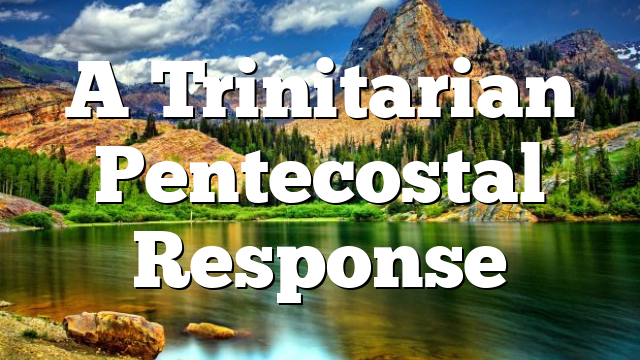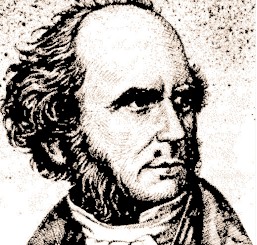Click to join the conversation with over 500,000 Pentecostal believers and scholars
Click to get our FREE MOBILE APP and stay connected
| PentecostalTheology.com



Pneuma 30 (2008) 240-244
A Trinitarian Pentecostal Response
Richard Shaka
North Central University, 910 Elliot Avenue, Minneapolis,
Minnesota 55404, USA
richard.shaka@northcentral.edu
Introduction
This final report is a result of six years of talks between Oneness and Trinitar- ian Pentecostals. Nothing parallel to the Second Vatican Council (1962-65), the Oneness-Pentecostal dialogues, commissioned by the Society for Pentecos- tal Studies (SPS), signaled a high level of collegiality between the two groups in matters of dogmas that have caused division between them for almost a century. The dialogue itself is a breakthrough and a landmark for Pentecostal unity since the birth of Pentecostalism in the 1900s. Thank God for the wis- dom of the Roman Catholic ecumenist and theologian, Kilian McDonnell, O. S. B., who suggested to the executive committee of the SPS such a dialogue and, for the dedication of the SPS executive committee, who not only endorsed and embraced the idea for such dialogue to take place, but also worked to sustain it from start to finish.
The purpose of this response, then, is clearly defi ned. Not meant as a cri- tique, but simply to discuss and highlight the salient features worthy of note in the fi nal report of the dialogue teams. Here, then, I will raise the issues highlighted by the teams and discuss the various dogmatic/biblical approaches each side has taken. Since the basic outline of the report is clearly articulated in broad strokes in the ad hoc report, I take liberty in following that same basic format as follows: sacramental (baptism), Christological (bordering on the question of the Trinity), soteriological (salvation), and sanctifi cation (holi- ness). However, before going into the dogma and biblical perspectives on both sides, it is necessary, first, to consider a response to the divinely appointed historical sketch that has led the Pentecostals to this point before I draw a conclusion.
© Koninklijke Brill NV, Leiden, 2008 DOI: 10.1163/157007408X346375
1
R. Shaka / Pneuma 30 (2008) 240-244
241
The Historical Break
First and foremost, I applaud the teams for their excellent job of analyzing the reasons for the division of the Pentecostal Movement into Oneness and Trini- tarian. The members’ dedication to explore the “common origins, experience, worship and fellowship,” between the Oneness and Trinitarian Pentecostal groups serves as a stepping stone towards this end. It is clearly indicated in the report that the objective of the dialogue partners, in the first place, “that fresh insights into commonalities would emerge to provide for more meaningful forms of witness between the traditions,” has been met. This is articulated in the joint affirmations emerging out of the passions inherent within the general framework and flavor of early Pentecostalism. This passion is a call from both sides to the church, to return to the apostolic ministry. It is a call to the church, to go back to the primitive kerygma and the maintenance of the holiness required by God and Scripture. This is the church’s true nature from its incep- tion and the basis for its existence in light of its eschatological expectations. The method applied by the teams is the genesis for any genuine call to dia- logue between groups of opposite views, because it will ultimately lead to a successful end. Indeed, the dedication of the teams to further explore the “com- mon origins, experience, worship and fellowship,” between the two groups also serves as stepping stone towards signifi cant advancement. This is refl ected in the rapport and personal bonding among team members and participants of the dialogue partners.
Nonetheless, since the teams were comprised of a limited number of schol- ars coming from both sides, it is hoped that the current report would serve as a “launching pad” for further discussion by a larger cross-section of scholars from more and varied contexts. For the moment, it is resolved by the commit- tee’s report that both the Oneness and Trinitarian groups still remain strong on their perspectives. It does not seem likely that there will be changes or com- promise on either side. Perspectives are already deeply rooted within the insti- tutional and cultural frameworks of the two movements.
The Afirmations
Dialogue between groups of deferring perspectives is usually aimed at accep- tance, affirmation, collegiality, conversion, correction, persuasion, under- standing, unity, etc. So, how are some of these reflected in the report on the dialogue that took place between the two movements? What conclusions did
2
242
R. Shaka / Pneuma 30 (2008) 240-244
the committee draw generally in terms that will give some hope to the pros- pect for unity between the two groups? From the list above, we see acceptance, affirmation and collegiality. We see understanding and partial unity, but there was no attempt to persuade or correct or convert any on either side. In essence, the true persona of each group remains the same and expressed in their affir- mations. I must point out that the teams did a profound job on this point, because it eliminated the fear that the groups might lose their identity and reason-for-being.
One signifi cant point on which the two groups principally came close to agreement was on biblical revelation. T ey agreed that all revelations must be “in harmony” with Scripture, and that there is no “private or new” revelation superior to the Holy Scriptures (both Old and New Testaments of the Bible). Beyond that, there does not seem to be any more suggestion of unity. In this regard, it is not an overstatement to suggest that even though there were no conversions and changing of minds, one thing remains hopeful, that is, the dawn of a new era in the Pentecostal movement. Another history has begun. Eff orts have been made from both sides, a silver line, indicating that the process which has now begun will continue to yield a commensurable result within the wisdom of God. In the meantime, four major points of the division which have been highlighted in the report still remain unresolvable. T ey are as follows: sacraments, Christology, salvation, and holiness. To these I will now turn my attention.
Unresolvable Tensions
The Sacrament of Baptism: The main concern here is not the actualization of water baptism itself. On this point, both Oneness and Trinitarian Pentecostal groups agree and believe in water baptism by immersion. The report points out their main points of disagreement resting on the formula applied by each group in water baptism. These are significant doctrinal matters which cannot be taken for granted.
T us, whereas the Oneness Pentecostal movement invokes the name of Jesus only in water baptism, the Trinitarian Pentecostal Movement invokes the Father, Son, and Holy Spirit in the baptismal formulae. The former claims that the Holy Spirit is the same as the “Spirit of Christ,” thereby integrating water baptism and the baptism in the Holy Spirit into a single spiritual experi- ence. The latter makes a clear distinction between the two experiences. The Trinitarian Pentecostal movement makes a distinction between water baptism
3
R. Shaka / Pneuma 30 (2008) 240-244
243
and the baptism in the Holy Spirit. The report points out that this diff erence was the major cause of the historical division. T ere do not seem to be any compromise at this point on the mode and formula on water baptism on either side.
Christology: This ontological understanding of the nature of Christ creates a schism between the Oneness and Trinitarian Pentecostals. The question bor- ders on monotheistic tendencies. The Trinitarians baptize in the name of the Trinity: Father, Son, and Holy Spirit. The Oneness baptize in the name of Jesus only. While the Trinitarian language is Patristic, Tertullianistic, Constan- tinian, and Nicene in its baptismal mode, it has a long ecclesiological support and acceptance over and against a Unitarian formula of the Oneness move- ment. The Trinitarians claim that the three persons in the Godhead (Father, Son, and Holy Spirit) are of the same essence (homoousios). On the other hand, the Oneness Pentecostal movement’s Unitarian language and mode, contends that the Godhead does not exist in three separate personas. God is viewed as being the same as Jesus, and the Spirit is the Spirit of Christ.
Salvation: The report of the Committee indicates that both groups afirm the salvation of humanity by God in Jesus Christ. This language is beautifully and narrowly crafted by the teams in their joint afirmation to the degree that one could hardly see any diff erence between the two. Yet, a closer look reveals a leaning by both sides toward the generally held monotheistic interpretation. The report shows that both agree that salvation comes through Jesus Christ alone with no merit whatsoever from the human side. Some other major dif- ferences still exist between the two groups. T ey appear mainly in the ways God’s salvation is made aff ective in Christ. For example, the report points out that while the Oneness group holds the view that salvation is inclusive of water baptism just as it is of Spirit baptism, the Trinitarian group believes that bap- tism in the Spirit is a progressive measure of sanctifi cation by the Holy Spirit. T ere is a clear understanding of the diff erent hermeneutics of both sides and, of course, no changes occurred by way of compromise.
Holiness: This was another major doctrinal diff erence that came up in the report. In the Oneness afirmation of holiness, the OT God is holy and He is the same God manifested in fl esh in the person of Christ. T erefore, Jesus Christ exemplifi es the holiness of God. The Old Testament God is now seen through the lenses of the New Testament Christ. This Christ demonstrated in his life the complete example of holiness and, it is the modality for all believ- ers. The report points out generally that the Oneness Pentecostal group insists on the form and mode of holiness. This group contends that holiness must also be demonstrated in the believer’s personal appearance and behavior,
4
244
R. Shaka / Pneuma 30 (2008) 240-244
including not only modesty and moderation, but also the avoidance of exces- sive ornamentation. On these points, more emphases are stressed on women, thus, pinpointing the distinction between male and female.
The Trinitarian view of holiness is inclusive. Here, the holiness of God has a Trinitarian outlook, demonstrated in the love which exists between the Father, Son, and the Holy Spirit. Accordingly, this Trinitarian love is further demonstrated by the Godhead through “the elect will of the Father, the obedi- ent devotion of the Son, and the faithful witness of the Holy Spirit.” T is holiness also reaches for a much broader scope, extending to the Apostolic and the Nicene traditions of the early church. T erefore, all believers can partici- pate in the redemptive strategy of the Father through the Godhead, Father- Son-Holy Spirit.
In conclusion, then, I must say that the dialogue teams have done a fantastic job completing the task that was cut out for them. The committee deserves much thanks and appreciation from all Pentecostal faith communities with a promise that all should continue to pray for the Pentecostal movement, work hard to encourage more dialogue and, advocate for unity within the Pentecos- tal movement as a whole.
5


